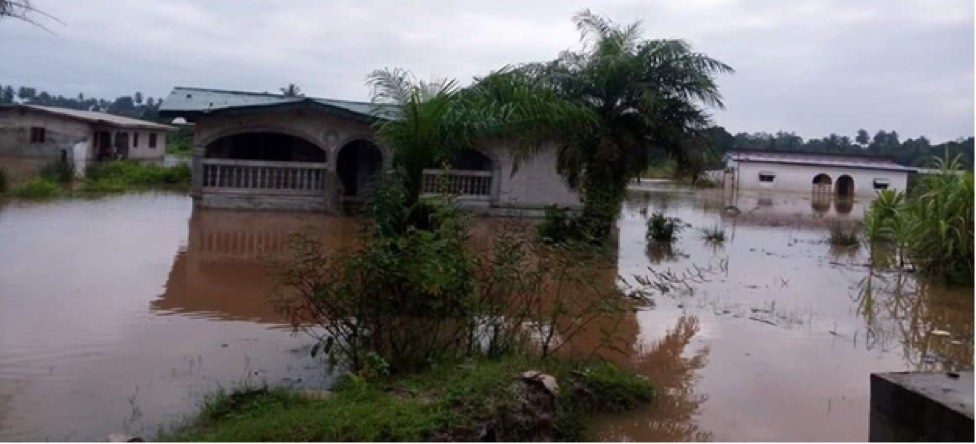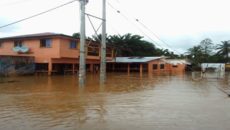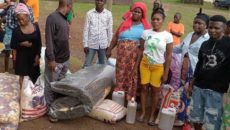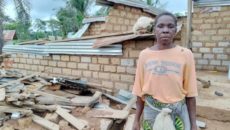MONROVIA, Montserrado – The National Disaster Management Agency has released national statistics for victims of floods caused by the heavy downpour of rain in July and August this year. The agency recorded that more than 50,000 individuals were impacted during the two months period in several communities of Margibi, Bomi, Montserrado, Sinoe, and Grand Bassa.
The NDMA is the government arm responsible for managing disasters and coordinating interventions from relief and collaborating institutions, including the National Public Health Institute of Liberia, the Ministry of Health, the Environmental Protection Agency, and other government agencies. NDMA also works with the Liberia National Red Cross and donor organizations.
According to the report, the floods destroyed nearly 2,000 properties, polluted water sources, increased food insecurity, and caused disease outbreaks in most of the affected communities, while also leaving several persons internally displaced, causing a serious humanitarian crisis. Women and children constituted more than 60 percent of all victims.
The agency’s communication director, Archievego Doe, told The Bush Chicken in an interview that the frequent flood disasters in Margibi was as a result of low lying lands and construction on waterways.
“Water sets on low land and so anyone who builds on such a land, obviously you must know that when there is rain, you will suffer from flooding,†Doe said.
The report disclosed that about 6,000 victims in Montserrado, Margibi, and Grand Bassa are currently receiving relief, including food and non-food items from agencies such as the World Health Organization, OXFAM, UNICEF, and the World Food Programme.

An abandoned building being used as shelter by flood victims in Grand Bassa. Photo: Sampson David
WHO provided 7,700 pieces of hand gloves and rain gears for safety workers and surgical and dressing materials for distribution to mobile health and ambulance teams and health facilities in affected communities. OXFAM was able to chlorinate more than 600 wells and 29 hand pumps. It also renovated latrines of two schools in Lower Margibi.
Nearly 100 family heads in affected communities in Margibi and Grand Bassa benefited from a distribution of hygienic kits, including buckets and WaterGuard from UNICEF, while WFP successfully transferred cash to 430 households in Margibi, in addition to distributing food to nearly 2,500 rural community victims without access to markets in Margibi and Grand Bassa.
At the same time, the United Nations refugee commission, UNHCR, announced that it provided 200 bills of used clothing, soaps, buckets, and blankets to 2,422 family heads in the two counties. Zionist Organization of America also provided food to 180 vulnerable household heads in Unification City in Lower Margibi.
In Sinoe and Bomi where the disaster was announced more recently, the NDMA said it would lead a team of experts from the U.N. Food and Agriculture Organization to assess the impact of the flood on victims’ livelihoods amid the bad road situation.
The NDMA report also noted that for July and August, 9,383 children were affected by the floods. It is not however known how many affected children are currently in school as most of the affected parents are mostly concerned about food and shelters.
Charles Quaqua, one of the victims in Lower Margibi who survives primarily on gardening, told The Bush Chicken that due to the losses incurred from the flood, he was unable to get three of his five children in school this year.
“I planted potato greens, peppers, and bitter balls, and that’s where we used to get money to support ourselves and send the children to school, but the water destroyed all [the crops] so, we have no other means to send them back to school,†he said.
“Nobody has ever come to our aid, to get money to buy uniform, shoes, and copy books.â€
NDMA reports that as the water level receded, some of the victims returned home and found their belongings damaged. Water sources were also polluted, thus creating socio-economic problems.

Drinking well damaged and polluted by the flood in Monclay’s Town, Lower Margibi. Photo: Sampson David
Oretha Douglas, a resident of Monclay’s Town in Lower Margibi, confirmed the report: “My mattress, my children’s food, my children’s footwear, dishes [are] all damaged.â€
“Now, there’s no pot for me to cook. I borrow a pot before I cook. We have nothing for food,†she said.
Douglas called on the government to provide some relief. She at the same time praised the county’s first district’s representative Tibelrosa Tarponweh for providing them with rice.
NDMA confirmed setbacks posed to the flood-affected communities but said it has received no funding or commitment to renovate the home of victims or help in getting their children back in school.
According to the agency, it is faced with huge challenges, including a lack of funding to compensate volunteers and enforce effective data collection for effective intervention for disaster victims.
“Considering the gaps and challenges of the response process, we recommend that the National Disaster Management Agency’s capacity for data collection and management be strengthened, and partners commit to supporting victims in Sinoe, and provide back to school packages for children,†the agency’s report noted.
Doe disclosed that the agency needs about US$10 million for logistics and preparedness. He said this would allow NDMA to provide shelter, food, and cash transfers to disaster victims.
The agency’s director, Henry Williams, also earlier disclosed during a press conference that investigation has shown that more than 500,000 people are likely to be affected by natural disasters in the coming year. He wants the government to prioritize adequate funding for the agency if it must adequately cater to disaster victims.
The agency’s budget under fiscal year 2018/2019 stands at US$930,000. Of the total allotment, US$5,000 is earmarked for capacity building, US$10,000 for workshops, conferences, symposia and seminars and US$20,000 for operational expenses.
Featured photo by Sampson David



